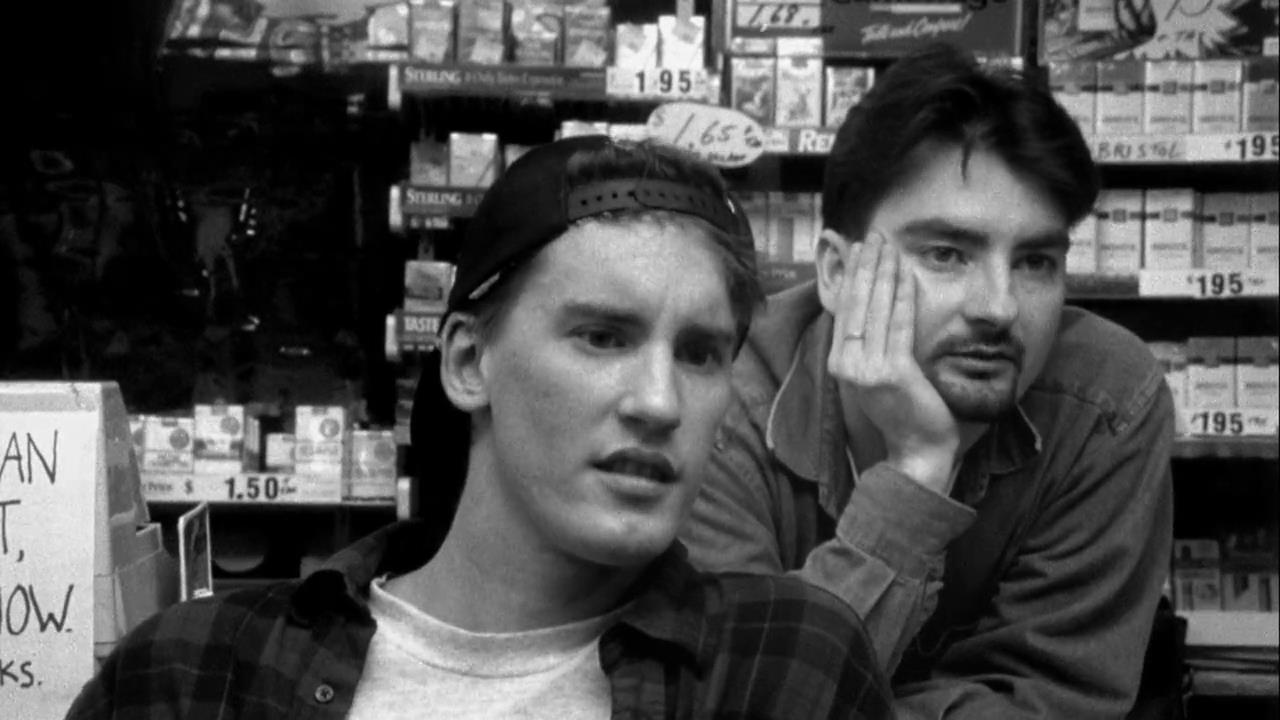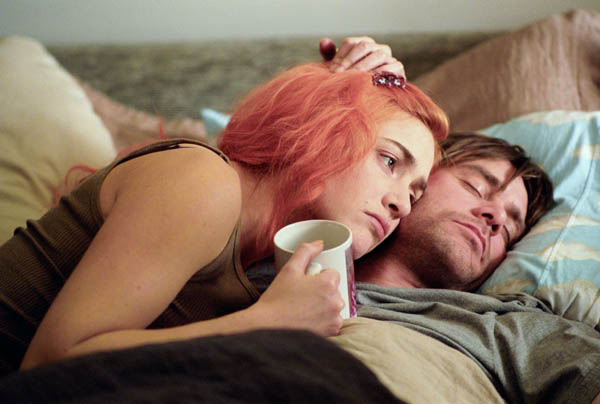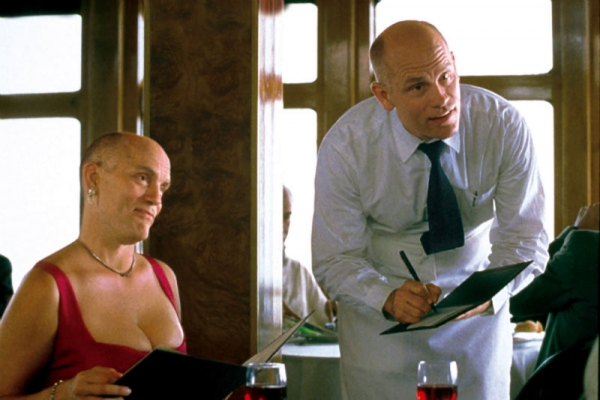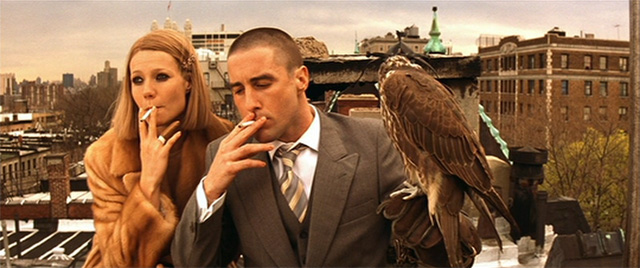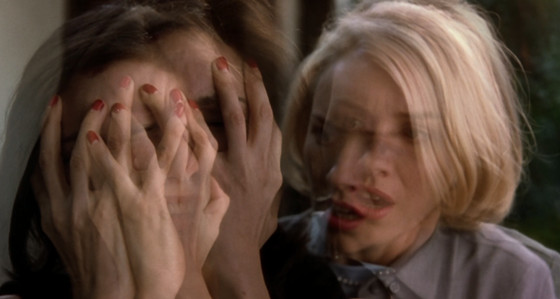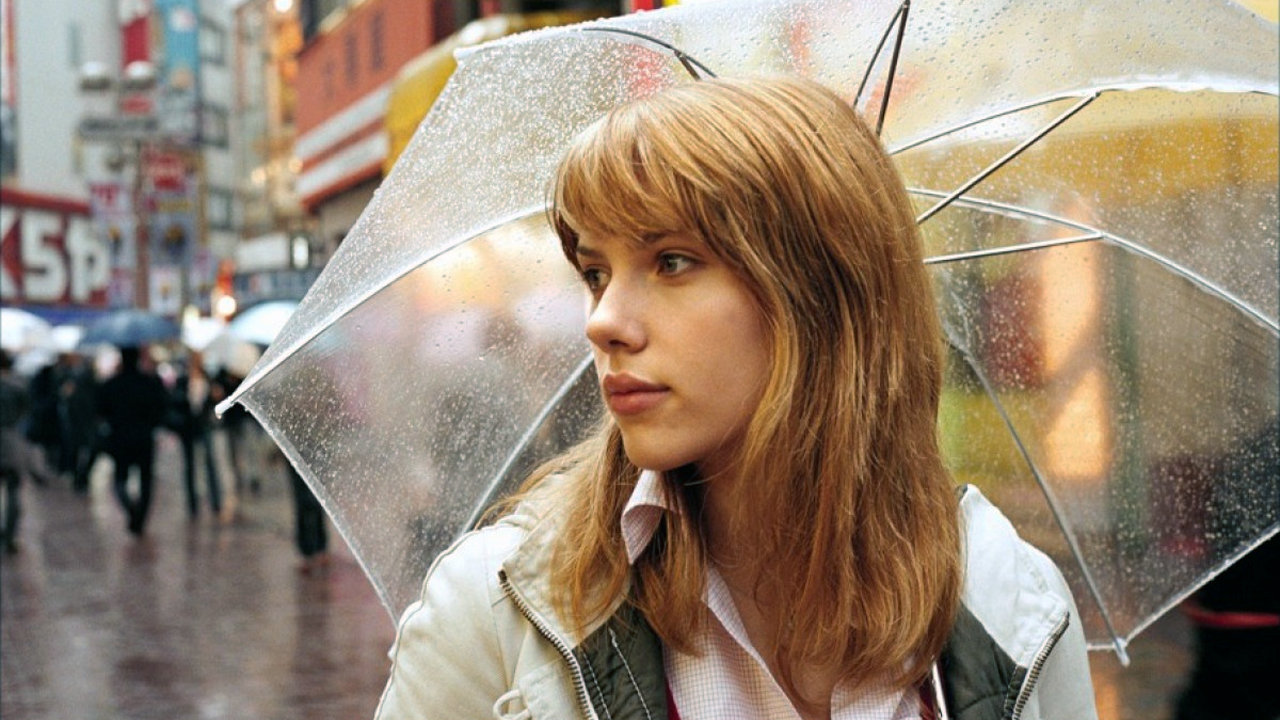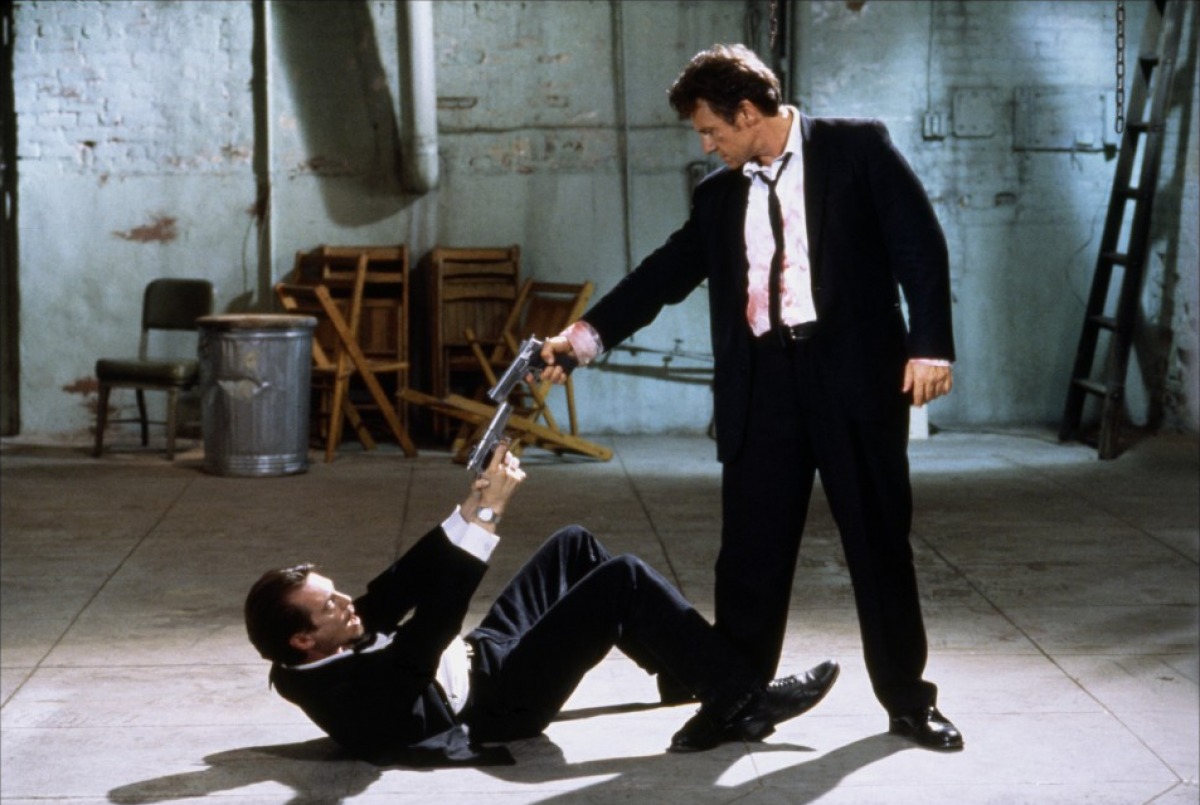7. Clerks (1994)
Here is another breakout success built upon financial shoestrings, yet this one is celebrated for dialogue and character rather than form and finance. Here, a 23 year old Kevin Smith shows us the brazen face of 1990s counter culture in a way that few indie films can match, even in this most postmodern of decades.
There are discussions about employment conditions aboard the death star, the difficulty of being a man during intercourse, cigarettes, and pornography. All in a days work at the Quick Stop and its neighbouring video store, not to mention aboard a Kevin Smith production. And, that’s before we even get to the significance of the number 37.
But there are surprises too. Masculinity and arrested childhood is explored. A hockey rooftop hockey game may come as a tonal surprise, not to mention the presence of death- both a funeral for a schoolmate and a wild incident involving a corpse that you wont forget in a hurry.
Ultimately, Dante’s eternal line “I’m not even supposed to be here today” or less sums it all up, this is a tale of the wandering 20s, an age where most have not found any direction in life yet. In Cannes in the same year as Pulp Fiction, 1994 made it clear that torch had been passed to a new era in American cinema.
6. Eternal Sunshine of the Spotless Mind (2004)
Eternal Sunshine of the Spotless Mind is many things. A love story, a break-up movie, a dreamy avant garde film, a visual experiment, an odyssey, a character piece. That a film can conform to so many archetypes and still be so original is very much to it’s credit.
The film’s playful visual experimentation plays off of the idea of fractured memory, of two lovers who try to erase each other from their pasts from their brains only to have it come screaming back to them in a bizarre dream narratives. We see Joel (Jim Carrey) and Clementine (Kate Winslet) lying in a bed on snow-capped beach, bathing in Joel’s mother’s sink, and caught in the rain indoors. The practical effects team seem to have truly extolled the best of their abilities here.
There are great supporting performances from Tom Wilkinson, Mark Ruffalo, Kirsten Dunst, and a truly creepy Elijah Wood. All of these performance make one’s trip to Lacuna Inc more than memorable. However, amidst all of the mad cap antics and characterisations, the film truly belongs to Jim Carrey and Kate Winslet.
Screenwriting wizard Charlie Kaufman is to be credited for the fact that such a wildly structured movie can, nonetheless, hold such a compelling romance as its central conceit. Furthermore, to have Kate Winslet play the wacky one and Jim Carrey play it straight is quite a bizarre thing to witness. But, the romance succeeds on the chemistry of its leads. For all of the visual mayhem, it is the character’s first encounter on a train that resonates most, and for all of the right reasons.
5. Being John Malkovich (1999)
As self-aware and bizarre as any 1990s film and, indeed as self-aware and bizarre a film as has been made in any era, Being John Malkovich served as the perfect catalyst to begin the partnership of writer Charlie Kaufman and director Spike Jonze. One wonders where to begin- with John Cusack as an obsessive puppeteer?
With a frightful looking Cameron Diaz looked in a cage? A mezzanine office with a comically low ceiling? Charlie Sheen in a wig? No, lets go with the fact that a portal exists into the mind of actor John Malkovich. Let’s go with that.
Yes, it is a tale of individuality and control. It is about who we are in relation to others and the right to self. However, it is also highly unusual. There is a fascist element to John Cusack’s Craig, abusing his wife Lotte and becoming intoxicated by his ability to control and “be Malkovich.”
It is rare in film history for a audience to be turned so violently against a protagonist that initially appears sympathetic. Sad characters abound in Doctor Lester and his “speech impediment” and the bitingly cynical Maxine (Catherine Keener). Fittingly, the glimmer of hope at the end is both odd and unclear. To see a major studio release idealogical puzzles like this is historically significant and can reinstate ones belief in film as a business.
4. The Royal Tenenbaums (2001)
The tagline “Family is not a word, it’s a sentence” is an apt one for the film that cemented Wes Anderson as a fixture of indie cinema.
When a family including a disdainful old sage Royal (Gene Hackman), his long-suffering ex-wife Etheline (Anjelica Huston), droll diva Margot (Gwyneth Paltrow), adversarial entrepreneur Chas, and troubled former tennis star Richie (Luke Wilson), find themselves under the same roof for the first time in years following the announcement that Royal is dying, tension and absurdity mounts. Of course, as does a sensational vintage soundtrack.
As always with Anderson, there is much colour and surreal character staging. The script, too, is wild and boisterous as lines such as “you want to talk jive, I’ll talk jive with ya” are given hysterical weight.
But, family runs deep, and so do the tender moments. Richie’s brush with suicide is followed by an unforgettable scene in a tent with Margot, the final moments between Royal and Chas are worth the film alone. As the family ensemble walk out of frame together at the end of the film, we feel like we have taken quite the journey with them.
3. Mulholland Drive (2001)
The greatest of puzzles are the ones you do not even wish to fully solve. Mulholland Drive is one of such puzzles. Originally conceived by David Lynch as a spin-off for the iconic Twin Peak’s character Audrey Horne, the TV series became a feature film and, for many critic’s, David Lynch’s final masterpiece.
The plot concerns the plight of Betty (or is it Diane), a young actress who moves to Hollywood only to find nightmares, death, and a complete loss of self. Typical Hollywood satire piece? Think again. However, Betty does find love in the form of Camilla, her housemate with whom she quickly forms a deadly enmeshment. In time, they form a romance, but all is not as it should be.
After over two hours of Billy Ray Cyrus, enigmatic cowboys, controversial sexual sequences and, most famously, a torrid affair at the back of a Shakey’s restaurant, you may be no closer to solving this great puzzle. Any “hints” provided by Lynch himself since the film’s release seem like pure jest. But, the emotion and beauty is there. The “silencio” scene is worth the viewing experience alone.
Love it or hate it, Mulholland Drive is a true landmark.
2. Lost in Translation (2003)
Lost in Translation is not a 2000s indie film, it is the 2000s indie film. It goes nowhere but where the characters dictate that it goes. It say nothing but what the sprawling Tokyo landscape wants it to say. It has a pulsating score, two infectious leads, and instantly unforgettable scenes. Most importantly of all, in a genre of hipsters and auteurs, Lost in Translation is very, very cool.
It’s cult following was almost instantaneous. The Tokyo landscape is breathtakingly set to the droll melodies of the synth pop group Air. The beauty and soul of Scarlett Johansson echoes through every scene. Her backside is impressive enough to warrant an extended close-up in the film’s opening shot. Her underwear-clad looks of longing as she sits against her hotel-room window, overlooking Tokyo, her teary cries for help to an unsympathetic friend, these are now the stuff of cinematic lore.
Of course, as any devotee of the film will tell you, Johansson does especially well when one considers the tour de force that she plays opposite. You see, this is the moment at which the world fell once again in love with Bill Murray. Murray is a revelation in this film. He plays Bob Harris, a washed up actor in Tokyo to shoot a nonsensical whiskey advert, with the kind of hilarious sarcasm that appeals to the world weary side of us all.
His ennui as a the instructions furiously enthusiastic advertisement director are poorly translated by an interpreter, his incredulousness on a ludicrously camp Japanese talk show, his attempts in vain to converse with an old woman in a hospital waiting room, are beyond priceless. But, in the end, the film is best summarised in a sequence in which Bob and Charlotte, now firm friends, lie on a bed together discussing the possible meanings of their existence. Bob’s grasp of Charlotte’s foot, along with his line “you’re not hopeless”, is as passionate as any sex scene.
The muted last line from Bob to Charlotte is apt. Were they lovers? Were they friends? In the end, it doesn’t seem to matter. They found each other for the briefest of times, and we the viewer felt every moment. Lost in Translation is a shameless, essential slice of indie cinema.
1. Reservoir Dogs (1992)
It is the best of indie cinema, it is the wildest of indie cinema. Reservoir Dogs is, in a manner of speaking, 90s cinema incarnate. Relishing budgetary restrictions rather than mourning them, Tarantino sets the bulk of his film in a warehouse, relying on a series of surgically placed flashback scene in other cheap locations to enhance the rhythm.
The film’s technique is virtually a complete success. Beginning at the narrative’s beginning in a coffee shop, the film then descends into Tarantino’s beloved fractured chronology. The opening discussion on Madonna announces Tarantino’s intentions, to break from the conceived ideas of audiences with regard to criminality. Criminality is anything but a formal thing here, these boys wrestle, joke, fight over names, eat fast food, and debate Pam Grier.
The film was not without its controversy. There is racism that is hard to come to terms with. Disturbing, too, is the joy one might wield from an ironically pitched torture scene in which a young cop is relieved of an ear whilst 70s hokum plays on a nearby radio.
However, the characters are well defined, be it Chris Penn’s oafish Nice Guy Eddie, the coward Mr Pink, or the shameless sociopath Mr. Blonde, this is a cast of characters that need no stunts or spectacle to hold our attention. Tarantino draws a scenario of slight tragedy at the end, but is careful not to lose his exuberant tone; a tone that would have an entire decade following suit.
Author Bio: Ross Carey is a Film Studies graduate from County Cork In Ireland. He is an award winning short filmmaker and is in the midst of writing his debut feature film. Before joining Taste if Cinema he was ran a popular blog entitled “Kino Shout! Films”. He will discuss the subject of film at any opportunity.
